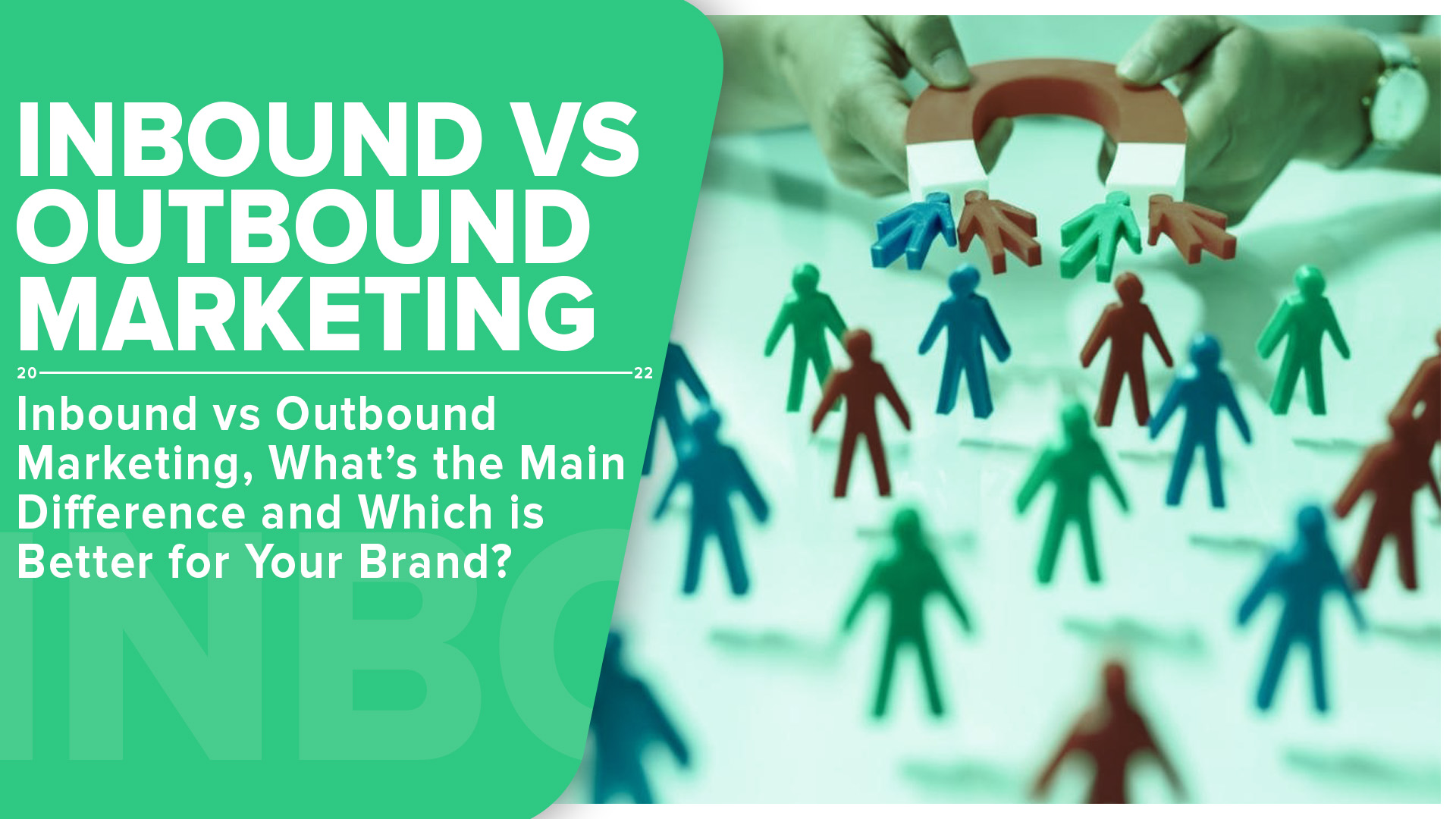
It’s a continuous battle between marketers debating which marketing techniques are better, inbound or outbound marketing.
To some of them, outbound marketing is the way to go.
On the other hand, other marketers say it’s an “old way of doing business” and prefer more sustainable techniques and choose inbound marketing.
Though as much as we would argue today which marketing methodology is better, we should agree that there’s no single answer to which is better. The fact is, that in some cases, especially more traditional forms of industries prefer outbound marketing, while more tech-savvy and less conservative industries such as technology startups prefer inbound marketing.
So without further due, in today’s articles, we’ll cover all you need to know about inbound and outbound marketing methods, what’s the difference between the two, and which is better for your business?
Lastly, in our Bonus part, we’ll share inbound and outbound marketing benefits and downsides.
Inbound vs Outbound Marketing
What’s outbound marketing?
Outbound marketing or better known as traditional marketing is a marketing strategy that focuses all energy to get your brand message in front of people against their own will. Outbound marketing methods could be perceived as interrupting or sometimes even irrelevant.
These are some examples of traditional outbound marketing channels:
- TV
- Radio
- Direct-mail
- Billboards
- Paid Ads
- Pop-Ups
- Sale calls
- Trade Shows
Despite which outbound marketing technique you would choose, many marketers go for outbound marketing with the hope to reach a broader target audience that is interested in your products and is willing to start a journey of becoming a customer.
The only problem with outbound marketing is, that nobody asks them and they are often perceived as interruptive. As the result, the following techniques usually have a terrible CTR, which is as low as 0,16% on mobile and as low as 0,06% on desktops.
What’s inbound marketing?
Inbound marketing is a less pushy marketing method that focuses efforts on creating high-quality content that pulls towards the company and its products. By focusing on what your customers naturally want and what problems they’re trying to solve, you naturally attract higher traffic to your site and convert more people over the same period.
Inbound marketing use content marketing, SEO, and social media techniques to attract people to sale funnels, and these are just a few of them:
- Blogging
- Email Marketing
- SEO
- Influencer Marketing
- Podcast
- Webinars
- Marketing Analytics
- Word of Mouth and Viral Marketing
- Video Content
Many marketers choose the following marketing techniques because they’re less pushy, more friendly, and generate better long-term relationships with them. However, at first, it might look intimidating and a long process to generate results through inbound marketing, but once the brand gets it, it produces fruitful results over a long period.
6 Differences between Inbound and Outbound Marketing
To better understand the concepts of inbound and outbound marketing we need to take a closer look at each of them side by side and compare the key differences.
Let’s look at each of these concepts and how inbound or outbound marketing stands out:
- Audience Engagement
- Paid vs Earned Attention
- Marketing Strategies
- Customer Focus
- Communication
- Data and Attribution Methods

1. Audience Engagement
Outbound Marketing
Outbound marketing methods are interruption-based and primarily work by finding medium sources with a large following and periodically interrupting them with dissociated and often irrelevant ads.
Hoping that at least a small percentage of people will be interested in your message and convert to customers.
Inbound Marketing
Inbound marketing methods are permission-based and there are two key permissions.
- The first one is when the customers subscribe to your email list and grants you access to send them occasional emails to continue the communication
- The second is answering questions people are asking online that relate to your industry and what problems do you solve.
In the first example, permission-based communication could take place in email marketing. Where your customers subscribe to a monthly newsletter and get discount codes for their next purchases over email. Despite that email lists can be relatively small and niched, they tend to generate massive CTR open rates with engagement rates over the top. On the flip side, growing an email list can be a challenge, but with the right strategy and patience, it’s possible.
Another inbound marketing example could be blogging. After you do your keyword research and understand your audience better and what problems they’re trying to solve, you write articles that help to solve these problems and share them online. This way attracts people through organic search that are interested in learning more about solving the issues.
2. Paid vs Earned Attention
Outbound Marketing
Many marketers know that with outbound marketing techniques you’re buying attention and you’re as good as your last campaign or a media buy. The effects are usually short-term or last as long as your continue paying for ads. The sales get some spikes and drop flat as soon as your stop running campaigns.
With outbound marketing techniques such as billboard campaigns, leads come in, and then the traffic slowly decreases. Then you don’t have what to do next but plan a new campaign with a different message.
Inbound Marketing
On the other hand, via inbound marketing, you earn the traffic, which becomes your company’s asset.
This process isn’t fast and it takes time to build an audience this way. Contrastly, spending a couple of thousands on PPC campaigns gets you massive traffic that depreciates as quickly as it came.
Just keep in mind that:
- It takes time to build your email list
- It takes time to rank organically on Google
- And build an audience on social media
However, the hard work eventually pays off and once you build your email list, it doesn’t disappear over the night, such as in your PPC campaigns. Even if you stop publishing articles for a year, most likely you’ll still gain people to your list, and traffic wouldn’t be gone over the night.
3. Marketing Strategies
Outbound Marketing
Outbound marketing takes a more linear marketing approach. Where your media channels work in the linear principle to generate traffic.
And you continuously have to look for new media channels to generate traffic and apply the same workflow. Share the brand message across the channels and expect to get similar results as in the previous channel.
Inbound Marketing
Contrastly, inbound marketing takes a more holistic approach and is more complicated than linear marketing strategies.
A holistic approach takes continuous work on your website, content strategy, sharing the unified brand message on social media, and implementing measurement tools to track your results.
Despite all this, many marketers could agree that holistic marketing starts with a strong foundation of the website. Ensure that the website is fast, has a responsive design, clear CTAs strategy, is well written and optimized.
Once the website is rock solid, start expanding your marketing campaigns to other channels. Create a strong content marketing strategy, lead nurture campaigns, social media marketing, and more.
4. Customer Focus
Outbound Marketing
When you think about product marketing, most outbound marketing strategies focus on the product and its benefits. Ads, flyers, billboards that tell how amazing your product or service is and why your customers should buy it.
This type of communication is brand-centric and all the spotlights are on the brand, featuring its benefits. In a sense, these marketing techniques push your product to the customers hoping that it will reach them at the right time when they’re ready to buy.
Inbound Marketing
When outbound marketing is focused on branded products, inbound marketing is focused on its customers and use tactics that align with the customer’s decision-making process:
- Awareness
- Consideration
- Purchase
Let’s assume that you’re running a peanuts store online and write a monthly blog to educate your audience on the health benefits of eating them. While people looking for more information on almonds health find one of your articles and enjoy reading it so much that decide to sign up for your newsletter.
Since then each week, they get new articles with tips on the health benefits of eating peanuts right to their inbox. Sometimes they get a special promotion code to get discounts on your production.
Finally, when they’ll be looking to order peanuts online, the first place they will turn to will be your store, because they’re already familiar with your brand so much that they’re ready to buy from you.
5. Communication Type
Outbound Marketing
When we talk about outbound marketing, its communication type is one-way. As a result, that means, that everything is about the brand, how good its products are, why the customers need them, and have a minimal opportunity for two-way communication.
Inbound Marketing
In contrast, inbound marketing is all about two-way communication. Brands care to hear what their customers think about their products.
For example, customers are encouraged to share blog posts, comment, and share their opinion. As the result, that puts the power back into their hands and forces brands to be transparent, honest, and authentic. If you want to crystalize your brand message, check our article on copywriting techniques and learn how to share your brand story through powerful copy.
Also, this feedback loop allows brands to hear what their customers think about them, which helps them to grow and fix business holes that don’t work.
6. Data & Attribution Methods
Outbound Marketing
It’s hard to measure success with outbound marketing techniques. Of course, we can ask customers, how they’ve heard about us, but in general, it’s quite hard to measure the success of outbound marketing.
Just think for a second, how would you measure how many new leads your PR newsletter campaign has generated in the past month? Sure, you’ll get some rough numbers by looking at some call spikes in your sales center, but in general, it will be hard to measure how effective your campaigns were.
Inbound Marketing
On the other hand, inbound marketing is all about digital marketing. And what happens online, can be tracked and measured.
Almost every step your customers take on your site could be measured. From the moment it visits the site to the moment it exists. You can see which pages he visited, how much time he spent, or which buttons he clicked.
This information is very valuable and allows us to attribute results to specific campaigns and potentially repeat them in the future.
Bonus Point
Pros and Cons of Inbound & Outbound Marketing
Each marketing techniques have their advantages and disadvantages. The same is with inbound and outbound marketing. Here are just a few of them.
1. The Advantages
Outbound Marketing Benefits:
Outbound marketing is beneficial because:
- You have more control over the timeline and what your customers get
- You get quicker conversions
- Get in front of your customers quickly
- Target a larger pool of new leads and customers
Inbound Marketing
Inbound marketing is beneficial because:
- Brands don’t rush to get quick results and understand that inbound marketing is a long-term process that takes time
- Customers don’t get bogged with your interruptive ads, and they come to you on their own will
- Nurtures customers in each step of the buyer journey
2. The Disadvantages
Outbound Marketing Disadvantages:
The key outbound marketing downsides are that:
- It may be perceived as spammy content or experience
- It interrupts customers with content they might not always want
Inbound Marketing
Inbound marketing has some drawbacks too:
- It takes significantly longer to generate new leads and customers than using outbound marketing methods
- Brands have less control over the customer’s experience, and some of the content they might not want to see
Conclusion
To summarize, outbound marketing techniques are more invasive and aimed to generate a huge amount of traffic. On the other hand, inbound marketing takes a more holistic approach and educates customers before they try to sell them.
Inbound and outbound marketing methodologies are different and they could be compared by these 6 criteria:
- Outbound marketing is interruptive, while inbound marketing is more inviting
- With outbound marketing, you buy attention, while with inbound marketing you earn it
- Outbound marketing takes a more linear approach, and inbound marketing takes a more holistic marketing strategies approach
- While outbound marketing focuses on brand and its greatness, inbound marketing is more customer-centric
- Outbound marketing takes a one-way communication type, that’s all about spreading the brand’s message. Contrastly, inbound marketing is about two-way communication, and brands value customers’ feedback because that allows them to grow
- Lastly, it’s hard to measure outbound marketing success. Differently, it’s much easier to measure inbound marketing because most of its tactics are happening in the digital space
However, inbound and outbound marketing techniques can’t be compared to each other, because each of them drives different results.
While for some, more conservative brands such as insurance industry outbound marketing techniques can be more helpful.
On the other hand, for the more tech-savvy brand, such as some dating startup app, data-driven inbound marketing techniques would be a better fit.
Nevertheless, all of us should probably agree that a mix of both methodologies is the best, and we need to continuously experiment with new inbound and outbound marketing techniques because we never might know what will work for our unique case.




